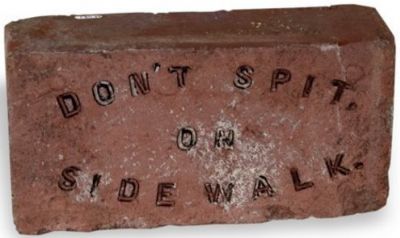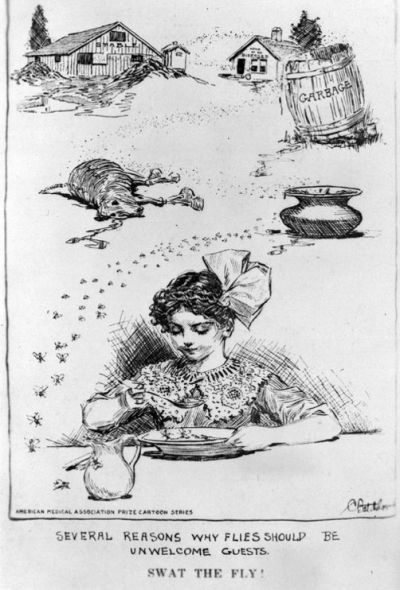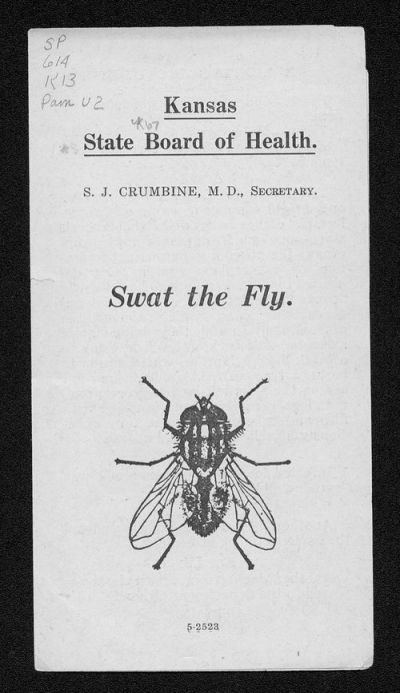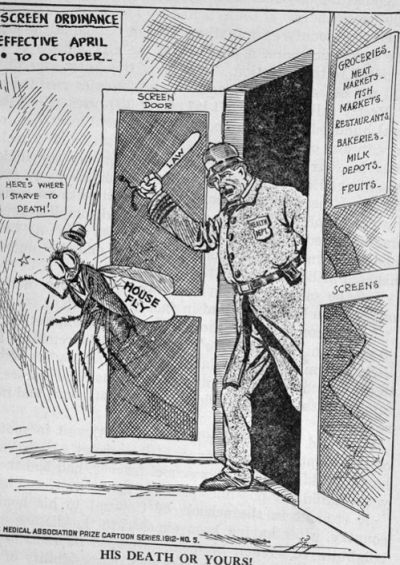Content provided by students of the Frontier Program at Kansas State University: Clara Wicoff, Danny Unruh and Sarah Jones, under the direction of Justin Kastner, Ph.D. Associate Professor, Department of Diagnostic Medicine/Pathobiology Faculty member, School of Applied and Interdisciplinary Studies
Flies and Infectious Disease
7 Min Read
Jun 30, 2000
By
Kansas Health Institute

While Crumbine did not carry a fly swatter in his hand at all times (as some supposedly thought!1), he was widely known for being “the nation’s most relentless worker in public health” whose “campaigns and inspirations have jarred the personal habits of every adult in the world.”2
In Frontier Doctor: The Autobiography of a Pioneer on the Frontier of Public Health, Crumbine wrote:
“In Kansas we had far too many cases of typhoid fever, far too many deaths from it and far too many flies. But people took flies for granted, considered them simply a nuisance and let it go at that. They had been doing this for years. How could we convince them that flies may carry typhoid germs, often caused epidemics? To get people to wage an unending war on flies was going to be some job.”3

To accomplish this task, Crumbine pioneered and distributed a “Fly Bulletin.” This bulletin included information about where flies bred, how to destroy fly larvae, and why flies could be dangerous to humans. This widely distributed literature encouraged people to have their houses screened and to clean up filth. In addition, each letter sent out by the Kansas State Board of Health was accompanied by a four-page leaflet with information about flies. Crumbine also displayed posters about flies “in every post office, city hall and public building in the state…[and] all the railroad stations in Kansas.”4
One inspirational event regarding the name of his public health campaign took place at a baseball game. While attending the opening baseball game of the season, Crumbine became confused while listening to fans yell “swat the ball” and “sacrifice fly.” This led Crumbine to coin the term “swat the fly.”5
In some ways, the “swat the fly” campaign was only the tip of the metaphorical iceberg of Crumbine’s storied efforts to reduce the spread of communicable illness. In this regard, an especially formative event in Crumbine’s life took place on a train in 1907. In his autobiography, Crumbine wrote,

“On board with me were a number of “lungers” on their way to the Southwest where they hoped to be cured of tuberculosis. Now the germs of this disease are readily transmitted, by an open case, to others who are well, and I was thinking of this danger when the heat began to make me inordinately thirsty. Getting up, I went to the water cooler at the end of the car where I found a man drinking from the common cup which in those days was part of the equipment of every railroad coach. The man’s emaciation, facial characteristics and hollow cough made it obvious that he was an advanced case of tuberculosis, so I went back to my seat without drinking. But the heat soon made my thirst such that I went into the next car, only to find that two people in there were also on their way to the water cooler. Of these two one was an adult obviously ill of tuberculosis, the other a tow-headed five-year-old girl who eagerly drank from the common cup after the tubercular adult had used it. This recalled what we had been trying to teach the public, how we had hammered home the idea that when anyone had tuberculosis he should be given separate eating and drinking utensils.

“But why urge people to do this, if so necessary a precaution was flouted every day on thousands of trains and in public places? Walking through the train, I noticed a number of people who seemed to me obvious “lungers” and several whom I questioned admitted that they were tubercular. While I sympathized with their search for health, the relief they hoped to find in the high, dry climate of Colorado or on the great desert plateau of the southwest, I could not help thinking of the endless chain of virulent organisms they were distributing across the country though the medium of the common drinking cup or glass… As I reflected, I realized that there should be a law, a law forbidding these common drinking utensils.”6
After returning to Topeka, Crumbine began the public health campaign that led to the common drinking cup being outlawed in Kansas in 1909.7
In addition to his activist campaigns against the fly and the common drinking cup, Crumbine led public health efforts that raised awareness of the health risks posed by the common roller towel and spitting on the sidewalk. According to a 1948 issue of The New Yorker, “the total effect of Dr. Crumbine’s blows at communicable illness was very encouraging; tuberculosis, smallpox, syphilis, and several more diseases fell off sharply in the next few years in Kansas. Another cheering result was that other states, and even other nations, began to follow his example.”8
Future public servants, especially those in public health, can look at Crumbine for inspiration and guidance. William Allen White considered Crumbine to be a true Kansas hero:
“Along with Kansas heroes – John Brown, Jim Lane, John J. Ingalls, Ed Howe, General Funston, and now General Eisenhower – the name of Dr. Samuel J. Crumbine should be written well toward the top, for his work was constructive, successful, and lasting. Kansas should honor him in its gallery of heroes.” 9
1. For more on this “absurdity,” see the 1948 letter from Samuel Crumbine to Miss Sylvia Covet; “Letter regarding absurdities to Miss Sylvia Covet,” 1948, Crumbine archives, Clendening History of Medicine Library, University of Kansas.
2. Robert Lewis Taylor, “Swat the Fly! – I,” The New Yorker, 17 July 1948.
3. S.J. Crumbine, Frontier Doctor (Philadelphia: Dorrance & Company, 1948). p. 157.
4. Ibid. p. 158.
5. Ibid. p. 159.
6. Ibid. p. 164-166.
7. Robert Lewis Taylor, “Swat the Fly! – II,” The New Yorker, 24 July 1948. p. 32.
8. Ibid. p. 32-34.
9. “Swat the Fly! – I.” p. 31.
Works Cited
Crumbine, S.J. Frontier Doctor. Philadelphia: Dorrance & Company, 1948.
Taylor, Robert Lewis. “Swat the Fly! – I.” The New Yorker, 17 July 1948.
———. “Swat the Fly! – II.” The New Yorker, 24 July 1948.
About Kansas Health Institute
The Kansas Health Institute supports effective policymaking through nonpartisan research, education and engagement. KHI believes evidence-based information, objective analysis and civil dialogue enable policy leaders to be champions for a healthier Kansas. Established in 1995 with a multiyear grant from the Kansas Health Foundation, KHI is a nonprofit, nonpartisan educational organization based in Topeka.